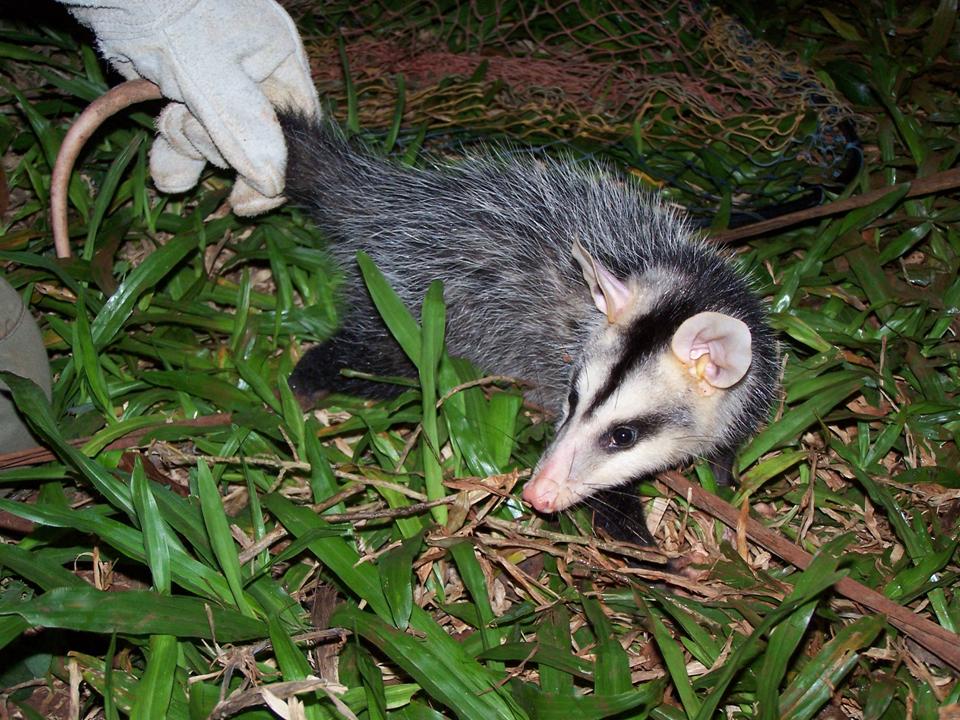
On the evening 20 March 2007 an adult White-eared Opossum Didelphis albiventris was captured whilst feeding in a mandarin tree at Estancia Nueva Gambach, Departamento Itapúa. The specimen was lethargic in its movements, continuing to feed despite the close proximity of observers. Whilst in the tree its only defence when approached was to seek a higher branch and periodically threaten silently with the mouth open. It was captured easily by hand by the tail, making no attempt to bite or flee and was immediately transferred to a large hand net.

Designed by Paul Smith 2006. This website is copyrighted by law.
Material contained herewith may not be used without the prior written permission of FAUNA Paraguay.
Photographs on this web-site were taken by Paul Smith, Hemme Batjes, Regis Nossent,
Alberto Esquivel, Arne Lesterhuis, José Luis Cartes, Rebecca Zarza and Hugo del Castillo and are used with their permission.
DEFENSIVE BEHAVIOUR OF A CAPTURED WHITE-EARED OPOSSUM
Didelphis albiventris: A SHORT NOTE
Paul Smith

Whilst in the net the opossum briefly played dead, lying on its side with eyes closed and mouth slightly open, but immediately became active when the net was removed. Hunsaker & Shupe (1977) report that death-feigning is documented, but is a rare occurrence in this species. It is well-known that individuals of this species are capable of producing a strong unpleasant odour when molested (Massoia et al 2000), but besides a slight musky scent this individual did not employ this defence. Whilst on the ground it did not use open-mouthed threat displays, nor produce any sound. In fact whilst it was held by the tail it seemed quite unaffected by its ordeal, attempting to walk but making no attempt to free its gripped tail as long as its forefeet were in contact with the ground. When it was raised from the ground it immediately responded aggressively, curling the body upwards and attempting to bite the hand of Lars Hansen who was holding it and it was duly released. It ran on the ground with a series of short jumps, an almost mustelid-like form of locomotion, and immediately headed for the nearest tree. Within a few minutes it was re-located, again feeding quietly on mandarins.
During September 2006 an individual of this species was observed feeding noisily on the ripe fruits of a Pindo Palm, the pieces of fruit falling to the ground betraying its presence. When approached with a torch it quietly and slowly hid itself between the dried palm fronds, from where it silently watched observers with only the nose and eyes visible. Shortly after sunset the same evening what was likely the same individual had been observed emerging from a fallen, hollowed out log where it had presumably been sleeping. When approached to within ten metres it immediately returned to the refuge of the log. The species apparently changes its sleeping place each evening (Hans Hostettler pers. comm.).
REFERENCES
Hunsaker D, Shupe D 1977 Behaviour of the New World Marsupials in Hunsaker D The Biology of Marsupials - Academic Press, New York.
Massoia E, Forasiepi A, Teta P 2000 Los Marsupiales de la Argentina - LOLA, Buenos Aires.
ACKNOWLEDGEMENTS
Thanks to Hans Hostettler and Lars Hansen who captured the individual during March 2007. Adam Betuel accompanied me in the field during September 2006.


